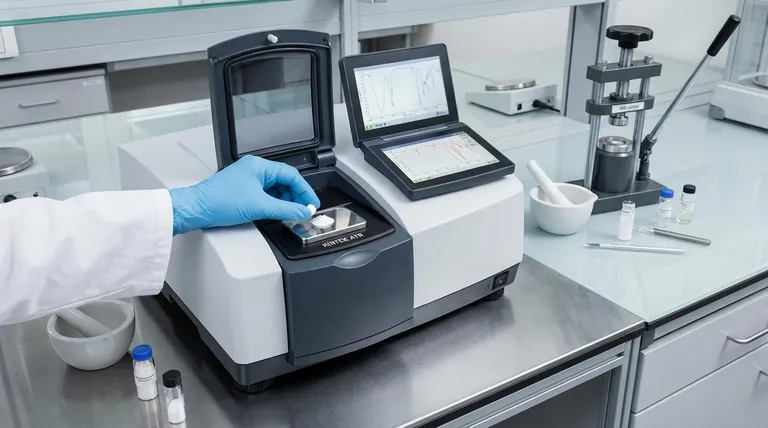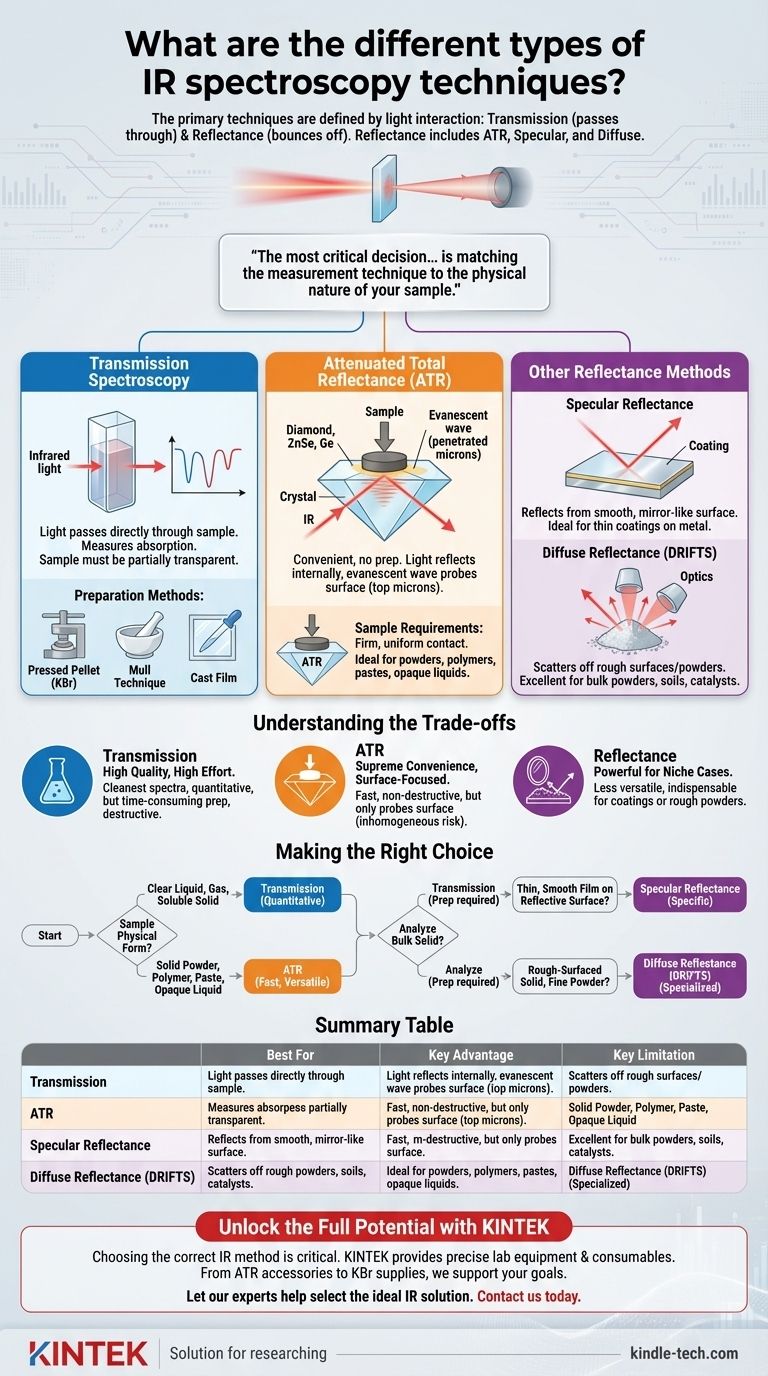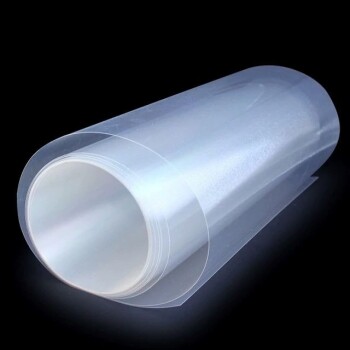Las técnicas principales en la espectroscopia IR se definen por cómo la luz infrarroja interactúa con la muestra, no solo por cómo se prepara la muestra. Los métodos principales son la Transmisión, donde la luz atraviesa la muestra, y la Reflectancia, donde la luz rebota en la muestra. La reflectancia en sí se divide además en técnicas clave como la Reflectancia Total Atenuada (ATR), la Reflectancia Especular y la Reflectancia Difusa.
La decisión más crítica en la espectroscopia IR es hacer coincidir la técnica de medición con la naturaleza física de su muestra. La elección entre Transmisión, ATR u otro método de reflectancia dicta todo, desde la preparación de la muestra hasta el tipo de información que puede obtener.

La base: Espectroscopia por Transmisión
La transmisión es el método clásico de espectroscopia IR. Opera bajo un principio sencillo: la luz IR se pasa directamente a través de una muestra, y el detector mide cuánta luz fue absorbida en cada longitud de onda.
Cómo funciona
El espectrofotómetro dirige un haz de radiación infrarroja a través de la muestra. La cantidad de luz que llega al detector se compara con la intensidad inicial del haz. El espectro resultante muestra "valles" donde las moléculas de la muestra absorbieron la energía.
Requisitos de la muestra
Para una medición de transmisión exitosa, la muestra debe ser parcialmente transparente a la luz infrarroja. Si es demasiado gruesa o demasiado concentrada, absorberá toda la luz, produciendo un espectro inútil. Por eso, a menudo se requiere una preparación de muestra exhaustiva para sólidos y líquidos concentrados.
Preparación común para la transmisión
Aquí es donde entran en juego los métodos que quizás haya escuchado, como las suspensiones (mulls) y las pastillas (pellets). No son técnicas de medición en sí mismas, sino métodos para preparar un sólido para una medición de transmisión.
- Pastilla prensada (KBr): La muestra sólida se muele finamente con una sal transparente a IR (bromuro de potasio, KBr) y se comprime bajo alta presión para formar un disco delgado y transparente.
- Técnica de suspensión (Mull): El sólido se muele hasta formar una pasta fina con un aceite de suspensión (como Nujol). Esta pasta se extiende luego entre dos ventanas transparentes a IR.
- Película fundida (Cast Film): Un sólido se disuelve en un disolvente volátil. Se coloca una gota de la solución sobre una ventana transparente a IR y se evapora el disolvente para dejar una película delgada de la muestra.
El caballo de batalla moderno: Reflectancia Total Atenuada (ATR)
La ATR se ha convertido en la técnica IR más común en los laboratorios modernos debido a su gran conveniencia. Es un método de reflectancia que permite el análisis de muestras sólidas y líquidas con poca o ninguna preparación.
Cómo funciona
En lugar de pasar la luz a través de la muestra, el haz de IR se dirige a un cristal especial de alto índice de refracción (a menudo diamante, seleniuro de zinc o germanio). En la superficie del cristal, la luz crea una "onda evanescente" muy superficial y no propagante que penetra unos pocos micrómetros en la muestra colocada en contacto estrecho con él.
El instrumento mide cómo esta onda es "atenuada" o absorbida por la muestra. Debido a que solo sondea la superficie superior, incluso las muestras completamente opacas pueden analizarse fácilmente.
Requisitos de la muestra
El único requisito es que la muestra pueda hacer un contacto firme y uniforme con el cristal ATR. Esto la hace ideal para polvos, láminas de polímero, líquidos viscosos, pastas e incluso sólidos blandos.
Herramientas especializadas: Otros métodos de reflectancia
Cuando la ATR no es adecuada, se utilizan otras técnicas de reflectancia para tipos específicos de muestras donde la luz debe rebotar en la superficie.
Reflectancia Especular
Esta técnica mide la luz IR que se refleja directamente desde una superficie lisa, similar a un espejo. Es el método ideal para analizar recubrimientos delgados sobre sustratos reflectantes, como un recubrimiento de polímero sobre un panel metálico.
Reflectancia Difusa (DRIFTS)
Abreviatura de Espectroscopia Infrarroja por Transformada de Fourier de Reflectancia Difusa, este método está diseñado para sólidos y polvos de superficie rugosa. La luz IR se dispersa desde la superficie irregular en muchas direcciones. Ópticas especiales recogen esta luz "dispersada difusamente" para generar un espectro. Es excelente para analizar polvos farmacéuticos, suelos y catalizadores.
Comprender las compensaciones
Elegir una técnica requiere equilibrar la conveniencia, el tipo de muestra y el objetivo analítico.
Transmisión: Alta calidad, Alto esfuerzo
La transmisión a menudo proporciona los espectros "más limpios" y de mayor calidad, lo cual es ideal para el análisis cuantitativo. Sin embargo, la preparación de la muestra requerida (p. ej., hacer una pastilla de KBr) puede llevar mucho tiempo, ser destructiva para la muestra y requiere habilidad para realizarse correctamente.
ATR: Conveniencia suprema, Enfocada en la superficie
La ATR es increíblemente rápida y no destructiva; simplemente requiere presionar una muestra contra el cristal y medir. Su principal limitación es que es una técnica de superficie. Solo analiza las micras superiores, lo que puede no ser representativo del material a granel si la muestra es heterogénea.
Reflectancia: Potente para casos específicos
La Reflectancia Especular y la Difusa son menos versátiles que la ATR, pero son indispensables para los tipos de muestras específicos para los que fueron diseñadas. Intentar analizar un recubrimiento sobre metal o un polvo rugoso con otra técnica probablemente produciría resultados deficientes o nulos.
Tomar la decisión correcta para su objetivo
La forma física de su muestra es la guía principal para seleccionar la técnica IR correcta.
- Si tiene un líquido claro, gas o sólido soluble: La Transmisión es el enfoque clásico y más cuantitativo.
- Si tiene un polvo sólido, polímero, pasta o líquido opaco: Comience con ATR. Es el método más rápido, fácil y versátil para la mayoría de las muestras.
- Si necesita analizar el volumen de un sólido y no solo su superficie: Utilice la Transmisión, lo que requerirá preparar una pastilla de KBr o una suspensión.
- Si está analizando una película delgada y lisa sobre una superficie reflectante: La Reflectancia Especular es la única técnica diseñada para esta tarea.
- Si está analizando un sólido de superficie rugosa o un polvo fino: La Reflectancia Difusa (DRIFTS) proporcionará el mejor espectro posible.
En última instancia, seleccionar la técnica correcta asegura que sus datos espectrales sean una representación verdadera y precisa de la composición química de su muestra.
Tabla de resumen:
| Técnica | Ideal para | Ventaja clave | Limitación clave |
|---|---|---|---|
| Transmisión | Líquidos claros, gases, sólidos solubles | Espectros de alta calidad y cuantitativos | Requiere preparación de muestra extensa (p. ej., pastillas de KBr) |
| ATR | Polvos, polímeros, pastas, líquidos opacos | Preparación de muestra mínima o nula, análisis rápido | Solo sondea la superficie (pocas micras superiores) |
| Reflectancia Especular | Películas delgadas sobre superficies reflectantes (p. ej., recubrimientos sobre metal) | Ideal para analizar recubrimientos superficiales | Requiere una superficie lisa, similar a un espejo |
| Reflectancia Difusa (DRIFTS) | Sólidos rugosos, polvos finos (p. ej., catalizadores, suelos) | Excelente para analizar polvos a granel sin disolución | Requiere óptica especializada |
Desbloquee todo el potencial de sus muestras con la técnica IR correcta
Elegir el método de espectroscopia IR correcto es fundamental para obtener datos precisos y fiables. Ya sea que su laboratorio necesite los espectros de alta calidad de la Transmisión, la conveniencia de ATR o las capacidades especializadas de los métodos de Reflectancia, contar con el equipo adecuado es clave.
KINTEK se especializa en proporcionar el equipo de laboratorio y los consumibles precisos que su laboratorio necesita. Desde robustos accesorios ATR hasta suministros para preparar pastillas de KBr, apoyamos sus objetivos analíticos con productos fiables y de alto rendimiento.
Permita que nuestros expertos le ayuden a seleccionar la solución IR ideal para sus aplicaciones específicas. Contáctenos hoy para discutir sus requisitos y asegurar que su laboratorio esté equipado para el éxito.
Guía Visual

Productos relacionados
- Instrumento de tamizado electromagnético tridimensional
- Potencióstato de estación de trabajo electroquímico de laboratorio para uso en laboratorio
- Molde de Prensa Infrarroja de Laboratorio
- Lente de silicio monocristalino de alta resistencia infrarroja
- Prensa Isostática en Caliente para Investigación de Baterías de Estado Sólido
La gente también pregunta
- ¿Qué es el tamizado de polvo? Una guía para la separación precisa del tamaño de partículas
- ¿Cuál es la velocidad de una máquina de tamizado? Optimice la vibración para la máxima eficiencia y precisión
- ¿Qué hace un tamiz vibratorio? Automatiza el análisis del tamaño de partícula para obtener resultados precisos
- ¿Cuál es el procedimiento operativo de un agitador de tamices? Domine el análisis preciso del tamaño de partícula
- ¿Cuáles son los componentes de una máquina tamizadora? Descubra la anatomía de la separación de partículas de precisión
















